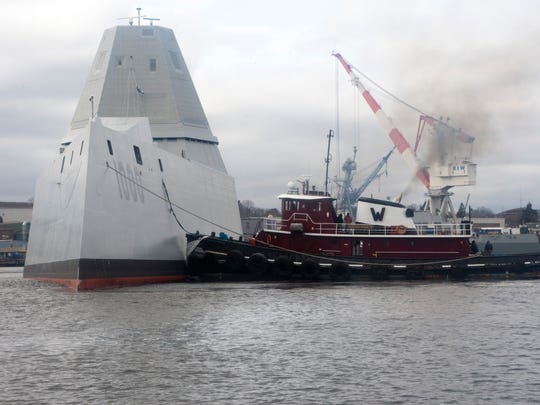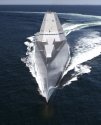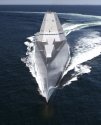You are using an out of date browser. It may not display this or other websites correctly.
You should upgrade or use an alternative browser.
You should upgrade or use an alternative browser.
US Navy DDG 1000 Zumwalt Class
- Thread starter Scratch
- Start date
Jura The idiot
General
to me, the most unusual view so far is this:

The future guided- missile destroyer USS Zumwalt (DDG 1000) departs the Bath Iron Works shipyard in March for its second at-sea period to conduct builder's trials. (Photo: Christianne M. Witten/US Navy)
Jura The idiot
General
LOL at first I noticed it as the top story at flotprom.ru
anyway Navy to Take Charge of Huge High-Tech Destroyer Worth $4 Billion
anyway Navy to Take Charge of Huge High-Tech Destroyer Worth $4 Billion
source:The U.S. Navy will soon take charge of the first in its newest, most advanced line of warships: the angular, tech-savvy — and expensive — USS Zumwalt.
The largest and most technologically sophisticated destroyer in the Navy's fleet, the USS Zumwalt will be the first of an ambitious class of three destroyers planned since the 1990s.
At 610 feet long, the USS Zumwalt will be the largest destroyer in the Navy. The final cost to build the behemoth is expected to be at least $4.4 billion.
The official handoff to the U.S. Navy will take place in a Bath, Maine, shipyard on Friday, Navy officials confirmed to ABC News.
The USS Zumwalt has an unusual, imposing, sharp-angled geometric design that keeps most of the superstructure enclosed. Because of its lines and shape, it will be 50 times as difficult to detect on radar as conventional ships its size.
It's also an energy-efficient machine, whose four gas-turbine engines power an integrated electric system that runs the ship's systems, including the propeller motors.
"The quiet and economical design of the destroyers' power system generates 100 percent of the energy needed for each vessel's propulsion, electronics and weapons systems," according to , the company that designed many of the technologies and equipment on board the Zumwalt.
The destroyer boasts a state-of-the-art weapon launcher designed to fire missiles for sea, land and air attacks, as well as an advanced gun system capable of striking targets over 70 miles away.
This time-lapse video, posted by the U.S. Navy, shows the ship's initial launch, in 2013.
During the testing phase for the ship, a lobsterman told The Associated Press that the vessel appeared to be a 50- to 60-foot fishing boat on his radar. When he saw the ship, he realized it was actually a massive Navy destroyer. In response to such feedback, the Navy added reflective material to the destroyer so it was more visible to other ships during testing.
The Zumwalt is named for Navy Adm. Elmo Zumwalt, who became the United States' 19th chief of naval operations in 1970. In more than 30years with the Navy, he served in and the Korean and Vietnam wars.
The ship will be formally commissioned in October in Baltimore, Capt. James Kirk, the destroyer's skipper, told Stars and Stripes.
The ship's home port will be San Diego.
ATLANTIC OCEAN (April 21, 2016) The future guided-missile destroyer USS Zumwalt (DDG 1000) transits the Atlantic Ocean during acceptance trials April 21, 2016 with the Navy's Board of Inspection and Survey (INSURV). The U.S. Navy accepted delivery of DDG 1000, the future guided-missile destroyer USS Zumwalt (DDG 1000). Following a crew certification period and October commissioning ceremony in Baltimore, Zumwalt will transit to its homeport in San Diego for a Post Delivery Availability and Mission Systems Activation. DDG 1000 is the lead ship of the Zumwalt-class destroyers, next-generation, multi-mission surface combatants, tailored for land attack and littoral dominance. (U.S. Navy/Released)
BATH, Maine (NNS) -- The Navy accepted delivery of future USS Zumwalt (DDG
1000), the lead ship of the Navy's next-generation of multimission surface combatants, May 20.
DDG 1000 is tailored for sustained operations in the littorals and land attack, and will provide independent forward presence and deterrence, support special operations forces, and operate as an integral part of joint and combined expeditionary forces.
Ship delivery follows extensive tests, trials and demonstrations of the ship's hull, mechanical, and electrical systems including the ship's boat handling, anchor and mooring systems as well as major demonstrations of the damage control, ballasting, navigation and communications systems.
"Today represents a significant achievement for not only the DDG 1000 program and shipbuilding team but for the entire U.S. Navy," said Rear Adm. (select) Jim Downey, DDG 1000 program manager, Program Executive Office Ships. "This impressive ship incorporates a new design alongside the integration of sophisticated new technologies that will lead the Navy into the next generation of capabilities."
The 610-foot, wave-piercing tumblehome ship design provides a wide array of advancements. The shape of the superstructure and the arrangement of its antennas significantly reduce radar cross section, making the ship less visible to enemy radar at sea.
Zumwalt is the first U.S. Navy surface combatant to employ an innovative and highly survivable Integrated Power System (IPS) distributing 1000 volts of direct current across the ship. The IPS' unique architectural capabilities include the ability to allocate all 78 megawatts of installed power to propulsion, ship's service, and combat system loads from the same gas turbine prime movers based on operational requirements. Each ship in the class features a battery of two Advanced Gun Systems, capable of firing Long-Range Land Attack Projectiles (LRLAP) that reach up to 63 nautical miles, providing three-fold range improvement in naval surface fires coverage. Each ship is equipped with eighty Advanced Vertical Launch System cells for Tomahawk missiles, Evolved Sea Sparrow Missiles, Standard Missiles, and Vertical Launch Anti-Submarine Rockets (ASROC) (VLA).
The ship will employ active and passive sensors and a Multi-Function Radar (MFR) capable of conducting area air surveillance, including over-land, throughout the extremely difficult and cluttered sea-land interface.
Following delivery and a crew certification period at General Dynamics-Bath Iron Works, the ship will be commissioned in Baltimore Oct. 15. Zumwalt will then transit to her homeport in San Diego where Mission Systems Activation will continue in parallel with a Post Delivery Availability.
"Zumwalt's crew has diligently trained for months in preparation of this day and they are ready and excited to take charge of this ship on behalf of the U.S. Navy," said Capt. James Kirk, commanding officer of future Zumwalt. "These are 143 of our nation's finest men and women who continue to honor Adm. Zumwalt's namesake with their dedication to bringing this ship to life."
BIW is also constructing follow-on ships, the future Michael Monsoor (DDG 1001) and Lyndon B. Johnson (DDG 1002).
As one of the Defense Department's largest acquisition organizations, PEO Ships is responsible for executing the development and procurement of all destroyers, amphibious ships, special mission and support ships, and special warfare craft.
Jura The idiot
General
hope you won't mind me posting the related story (by DefenseNews)
US Navy Takes Ownership of Stealth Destroyer Zumwalt
source:Shipbuilder General Dynamics Bath Iron Works formally delivered the stealth destroyer Zumwalt (DDG 1000) to the US Navy Friday, marking a turnover of ownership from the ship’s status as a private vessel to become a government-owned warship.
“Today represents a significant achievement for not only the DDG 1000 program and shipbuilding team but for the entire US Navy,” Capt. Jim Downey, the Zumwalt-class program manager at Naval Sea Systems Command, said in a statement. “This impressive ship incorporates a new design alongside the integration of sophisticated new technologies that will lead the Navy into the next generation of capabilities.”
Delivery represents a major milestone in the design and development of the ships, conceived in the late 1990s as the epitome of stealth in warship design. At various times the Navy envisioned 32 ships in the class, then 28, then seven, then two, and back up to three – the class size of today.
Concept and design work has been taking place on the Zumwalt class since the late 1990s, when it was known as the Land Attack Destroyer variant of the Surface Combatant 21 (SC 21) program. It was known as the DD(X) program in 2002 when Northrop Grumman and Raytheon were chosen as the prime contractors, and recast as the DDG 1000 in April 2006.
For a variety of reasons prime contractor responsibility shifted to the Navy, with General Dynamics Bath Iron Works overseeing the hull, mechanical and engineering (HM&E) portion of the shipbuilding contract. Raytheon retains overall responsibility for the combat system.
A construction contract was awarded for the Zumwalt in Feb. 2008, when the ship was expected to be delivered in July 2014. A keel-laying ceremony was held in November 2011 at Bath’s Maine shipyard, and the destroyer was launched in October 2013.
The Zumwalt first went to sea in December 2015 for Alpha trials, a series of tests run by the shipbuilder to test the ship’s HM&E components. A second Bravo trial was held in March, and the Navy’s Board of Inspection and Survey (INSURV) completed out a two-day acceptance trial on April 21.
With delivery, the Zumwalt’s Navy crew has officially moved aboard and taken up residence. She’s expected to sail away from Bath this fall and will likely operate for a few weeks from the fleet base at Norfolk, Va., travelling to Baltimore, Md., for an October 15 commissioning ceremony. After that, the Zumwalt will leave the US East Coast for her homeport of San Diego.
Work on the Zumwalt is by no means finished. A new phase will begin in 2017 as Raytheon and the Navy work to complete the ship’s combat systems – an array of radars, sensors and weapons. By late 2017 or the first part of 2018, the Zumwalt should be ready for combat system operational testing (CSQT), when the weapons and sensors will be fully tested. Only after the successful completion of CSQT will the Zumwalt work up for a deployment.
Two more Zumwalt-class ships, the Michael Monsoor (DDG 1001) and Lyndon B. Johnson (DDG 1002), are under construction at Bath.










